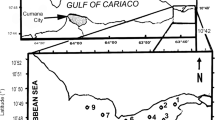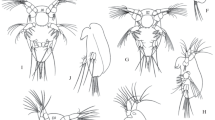Abstract
Resting eggs of copepods, cladocerans, and a rotifer were found in sediments from water depths of 60 to 120 m off the northern coast of California in February and April 1989. Eggs occurred as deep as 10 cm in the sediment. These eggs were viable, as evidenced by their hatching (41 to 58%) at 14°C in the laboratory.
Similar content being viewed by others
Literature cited
Craib, J. (1965). A sampler for taking short undisturbed marine cores. J. Cons. perm. int. Explor. Mer 30: 34–39
Drake, D., Cacchione, D. (1989). Estimates of the suspended sediment reference concentration (Ca) and resuspension coefficient (γ 0) from near-bottom observations on the California shelf. Contin. Shelf Res. 9: 51–64
Fuller, C., Butman, C. A. (1988). A simple technique for fine-scale vertical sectioning of fresh sediment cores. J. sedim. Petrol. 58: 763–768
Grice, G. D., Marcus, N. H. (1981). Dormant eggs of marine copepods. Oceanogr. mar. Biol. A. Rev. 19: 125–140
Kasahara, S., Uye, S., Onbé, T. (1974). Calanoid copepod eggs in sea-bottom muds. Mar. Biol. 26: 167–171
Kasahara, S., Uye, S., Onbé, T. (1975). Calanoid copepod eggs in sea-bottom muds. II. Seasonal cycles of abundance in the populations of several species of copepods and their eggs in the Inland Sea of Japan. Mar. Biol. 31: 25–29
Landry, M. (1975). Dark inhibition of egg hatching of the marine copepodAcartia clausi Giesbr. J. exp. mar. Biol. Ecol. 20: 43–47
Lindley, J. A. (1986). Dormant eggs of calanoid copepods in sea-bed sediments of the English Channel and southern North Sea. J. Plankton Res. 8: 399–400
Marcus, N. H. (1984). Recruitment of copepod nauplii into the plankton: importance of diapause eggs and benthic processes. Mar. Ecol. Prog. Ser. 15: 47–54
Marcus, N. H. (1989). Abundance in bottom sediments and hatching requirements of eggs ofCentropages hamatus (Copepoda: Calanoida) from the Alligator Harbor region, Florida, Biol. Bull. mar. biol. Lab., Woods Hole 176: 142–146
Mullin, M. M., Brooks, E. R., Reid, F. M. H., Napp, J., Stewart, E. F. (1985). Vertical structure of nearshore plankton off southern California: a storm and a larval fish food web. Fish. Bull. U.S. 83: 151–170
Onbé, T. (1978a). Distribution of the resting eggs of marine cladocerans in the bottom sediment of Ise Bay and Uragami Inlet, Central Japan. Bull. Jap. Soc. scient. Fish. 44: p. 1053
Onbé, T. (1978b). Sugar flotation method for sorting the resting eggs of marine cladocerans and copepods from sea-bottom sediment. Bull. Jap. Soc. scient. Fish. 44: p. 1411
Onbé, T. (1985). Seasonal fluctuations in the abundance of populations of marine cladocerans and their resting eggs in the Inland Sea of Japan. Mar. Biol. 87: 83–88
Raymont, J. (1983). Plankton and productivity in the oceans. Vol. 2. Zooplankton. Pergamon Press, Oxford
Revsbech, N. P., Sørensen, J., Blackburn, T., Lomholt, J. P. (1980). Distribution of oxygen in marine sediments measured with microelectrodes. Limnol. Oceanogr. 25: 403–411
Snell, T. W., Burke, B. E., Messur, S. D. (1983). Size and distribution of resting eggs in a natural population of the rotiferBrachionus plicatilis. Gulf Res. Rep. 7: 285–287
Sullivan, B., McManus, L. T. (1986). Factors controlling seasonal succession of the copepodsAcartia hudsonica andA. tonsa in Narragansett Bay, Rhode Island: temperature and resting egg production. Mar. Ecol. Prog. Ser. 28: 121–128
Uye, S. (1980). Development of neritic copepodsAcartia clausi andA. steuri. I. Some environmental factors affecting egg development and the nature of resting eggs. Bull. Plankton Soc. Japan 27: 1–9
Uye, S. (1983). Seasonal cycle in abundance of resting eggs ofAcartia steuri Smirnov (Copepoda: Calanoida) in sea-bottom mud of Onagawa Bay, Japan. Crustaceana 44: 103–105
Uye, S., Fleminger, A. (1976). Effects of various environmental factors on egg development of several species ofAcartia in southern California. Mar. Biol. 38: 253–262
Uye, S., Kasahara, S., Onbé, T. (1979). Calanoid copepod eggs in sea-bottom muds. IV. Effects of some environmental factors on the hatching of resting eggs. Mar. Biol. 51: 151–156
Author information
Authors and Affiliations
Additional information
Communicated by J.M. Lawrence, Tampa
Rights and permissions
About this article
Cite this article
Marcus, N.H. Calanoid copepod, cladoceran, and rotifer eggs in sea-bottom sediments of northern Californian coastal waters: Identification, occurrence and hatching. Mar. Biol. 105, 413–418 (1990). https://doi.org/10.1007/BF01316312
Accepted:
Issue Date:
DOI: https://doi.org/10.1007/BF01316312




